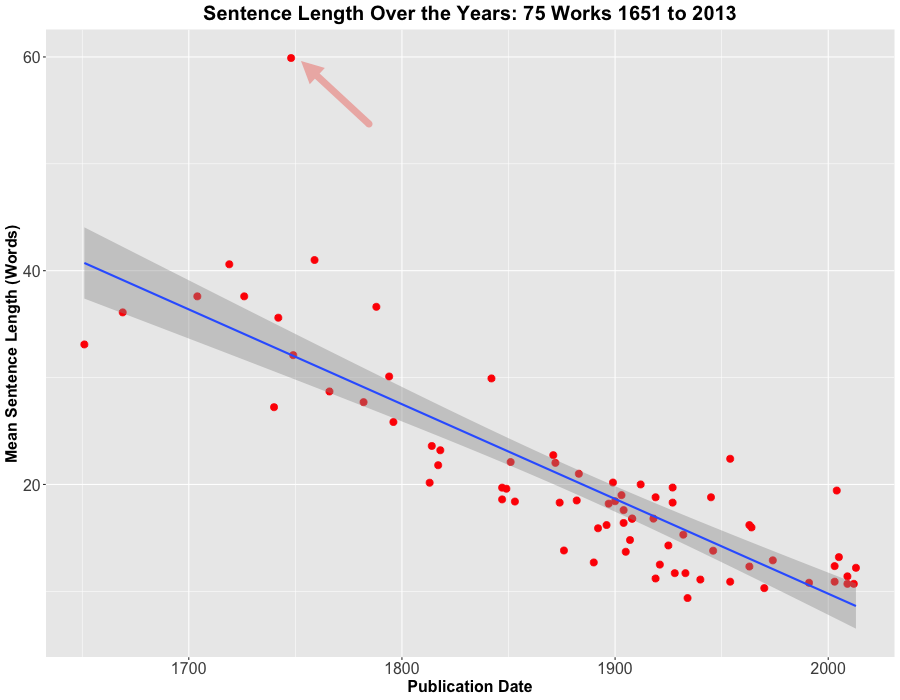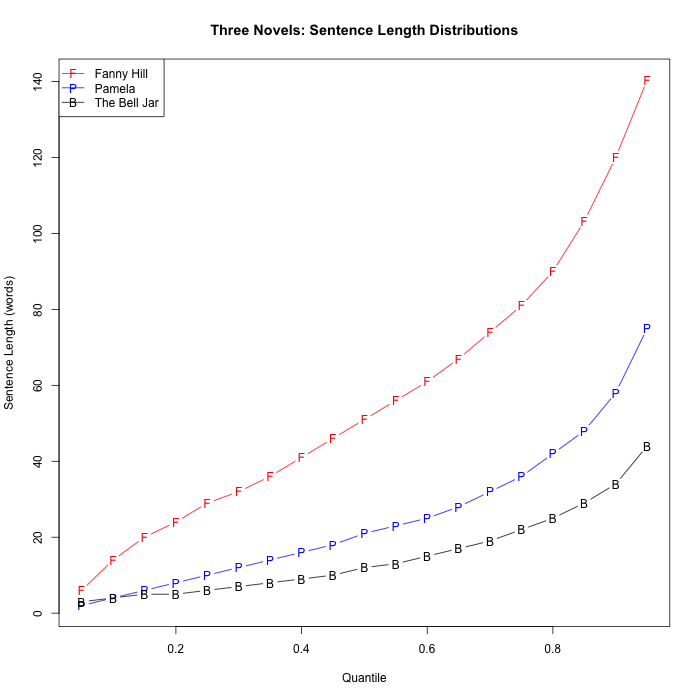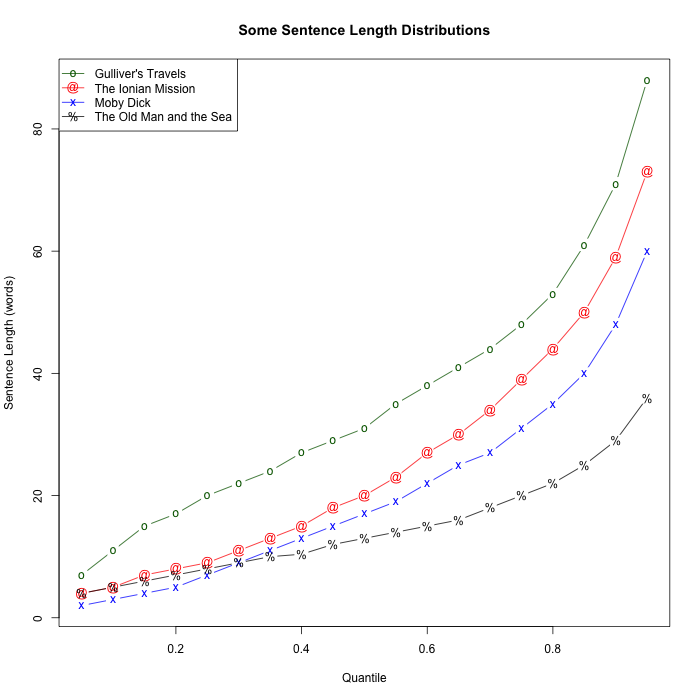Memoirs of a Woman of Long Sentences
« previous post | next post »
In the question period after my virtual talk yesterday at SHEL 12, an alert audience member asked about the outlier in a graph that I showed of average sentence length over the centuries. The outlier is marked with an arrow in the plot below, though no such arrow singled it out in the presentation:
I had been struck by the same point when I made the graph, and identified the work and author as John Cleland's 1748 epistolary novel, "Memoirs of a Woman of Pleasure", commonly known as Fanny Hill.
Here are the first two sentences of the work:
I sit down to give you an undeniable proof of my considering your desires as indispensable orders. (17 words)
Ungracious then as the task may be, I shall recall to view those scandalous stages of my life, out of which I emerg'd, at length, to the enjoyment of every blessing in the power of love, health, and fortune to bestow; whilst yet in the flower of youth, and not too late to employ the leisure afforded me by great ease and affluence, to cultivate an understanding, naturally not a despicable one, and which had, even amidst the whirl of loose pleasures I had been tost in, exerted more observation on the characters and manners of the world than what is common to those of my unhappy profession, who looking on all thought or reflection as their capital enemy, keep it at as great a distance as they can, or destroy it without mercy. (134 words)
The work's mean sentence length is 59.9.
We can compare Fanny Hill's sentence-length distribution with those of Samuel Richardson's 1740 epistolary novel Pamela, which has a mean sentence length of 27.2, less than half as great, and Sylvia Plath's 1963 novel The Bell Jar, which has a mean sentence length of 16.2:
We could look at other works by John Cleland to see if the long sentences in Fanny Hill were a stable characteristic of his style, or his idea of how someone like Ms. Hill would write.
His follow-up 1751 novel, Memoirs of a Coxcomb has a mean sentence length of 39.0 words. The overall comparison of quantiles:
So Cleland tends to longish sentences, even for his time period — but Fanny Hill remains an outlier. It's plausible that this represents the application of a gender stereotype similar to Ursula K. Le Guin's.
Update: From Colette Moore — "Sounds like John Cleland wrote the syntactic model for Molly Bloom :-)."



Cervantes said,
May 21, 2022 @ 10:06 am
Evidently Faulkner is not in your database, nor Joyce.
[(myl) The Reivers is in there: mean sentence length 15.4 words…
And Dubliners, mean sentence length 14.9 words.
As for Ulysses, Molly Bloom's soliloquy (chapter 18) is more than 20k unpunctuated words — but the rest of the book has a mean sentence length of only 10.6 words.]
Barry Fernelius said,
May 21, 2022 @ 11:19 am
Then, there's Proust.
[(myl) And Proust certainly has long sentences — mean sentence length in words of À l'ombre des jeunes filles en fleurs is 37.9 — but the stylistic history of French sentence lengths seems to be different. ]
Kai said,
May 21, 2022 @ 9:28 pm
Is Hobbes in there? (I do see one point in the plot around 1651.) I distinctly remember Leviathan (1651) – though I never managed to read that much of it – has a lot of paragraph-length sentences. That said, it seemed to be mainly a stylistic thing of using semicolons instead of periods to separate many sentences.
[(myl) Leviathan has a mean sentence length of 33.1, and 422 semicolons per 100k characters:
]
Kate Bunting said,
May 22, 2022 @ 10:05 am
I don't know what Patrick O'Brian's mean sentence length is, but he can produce some pretty long ones. This one occurs in 'The Ionian Mission' following a scene where Jack Aubrey and Stephen Maturin have been discussing J.S. Bach and then trying out a piece by him:
Perhaps there was not: but after a particularly difficult, severe and abstract passage the last movement ended with a triumphant summing-up and resolution that they could both play at first sight and that they repeated again and again; and the grave happiness of the music was still with Captain Aubrey when he walked on to his quarterdeck in the bright morning to see his stump topgallantmasts and their attendant royals come aboard, followed almost immediately by the Tamar’s barge bringing a score of glum but resigned and obviously competent Skates to the larboard side and by a Plymouth wherry with two pink-faced young men, very carefully shaved, wearing identical uniforms, their best, and solemn expressions.
[(myl) Mean sentence length of The Ionian Mission is 27.1 words, which is certainly on the long side for its publication date of 1981. Of course, this is not the only way in which O'Brian's style is self-consciously antique.
Comparing a few quantile plots:

]
Andreas Johansson said,
May 23, 2022 @ 2:03 am
I've been told a number of times that I tend to use unusually long and complex sentences in speech. No-one's suggested it's somehow effeminate, though.
As far as I know, I do not use semicolons in speech.
Thomas said,
May 23, 2022 @ 2:04 am
Judging from the plot, we can expect negative sentence lengths starting from the 22nd century. Maybe Poisson regression would be a better fit to the problem.
Edwin Williams said,
May 23, 2022 @ 10:24 pm
The most unwieldy writing I know of is Robert Boyle in the Skeptical Chemist. The longest sentence in it is 454 words, with 7 semicolons. (it starts "I take then the filings of…" and the text is available at https://www.gutenberg.org/cache/epub/22914/pg22914.txt.) The average sentence length is very high, even taking semicolons as periods, but I am not sure what it is–it is a little tricky to automate the count, as the period has other uses than sentence termination (e.g. "e.g."). In the preface Boyle complains about the difficulty in understanding other chemists' writings–"These Things I add, because a Person any Thing vers'd in the Writings of Chymists cannot but Discern by their obscure, Ambiguous, and almost Ænigmatical Way of expressing what they pretend to Teach, that they have no Mind, to be understood at all, but by_ the Sons of Art _(as they call them) nor to be Understood even by these without Difficulty And Hazardous Tryalls."
[(myl) My sentencizing code seems to do a good job on that file. And after removing the Gutenberg boilerplate, it estimates the mean sentence length of THE SCEPTICAL CHYMIST: OR CHYMICO-PHYSICAL Doubts & Paradoxes, Touching the SPAGYRIST'S PRINCIPLES Commonly call'd HYPOSTATICAL, As they are wont to be Propos'd and Defended by the Generality of ALCHYMISTS (old-fashioned long titles, right?) as 65.6 words.
Semicolonically, the work has 974 semicolons in 497130 characters, for a rate of 195.92 per 100k. ]
Philip Taylor said,
May 24, 2022 @ 12:47 pm
"Ænigmatical" — I like that. I am puncilious in my use of the æ ligature digraph in words such as "mediæval", "encyclopædia", "palæography", and so on, but had never considered using it in "ænigmatic[al]". I shall henceforth, of course.